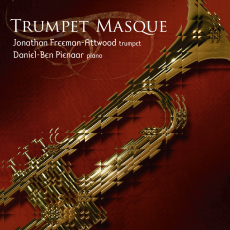Trumpet Masque - Jonathan Freeman-Attwood - Atlanta Audio Society
Trumpeter Jonathan Freeman-Attwood and pianist Daniel-Ben Pienaar join forces in Trumpet Masque, a splendid program of thrilling and colorful music of composers who flourished between 1600 and 1700, give or take a few years. It was an exciting time in the history of music, one in which the distinctions between scared and secular still held, an age when towering masterpieces of a capella vocal music were created, together with history's first operas, and the old liturgical modes were slowly beginning to give way to modern tonality. Instrumental music, still in comparative infancy, was growing up fast.
It was also a golden era of brass music, in which trumpet virtuosi, progressing from the Renaissance cornetto to the "natural" trumpet of the Baroque and finally the modern trumpet with valves, developed the techniques of double-tonguing, trilling and other embellishments, and highly expressive vocal lines that imitated and amplified the great music of an age in which the vocal tradition was still pre-eminent. Most of the music on this program is heard in modern transcription, in handsome arrangements by Pienaar, though there is no reason to believe that contemporary 17th century musicians were sluggards at adapting vocal and organ music for their own needs.
Sixteen composers are represented here: Louis Marchand, Francois Couperin, Giovanni Gabrieli, Joan Cabanilles, Francisco Correa de Arauxo, Heinrich Schütz, Claudio Monteverdi, Dietrich Buxtehude, Georg Böhm, John Dowland, Anthony Holborne, Henry Purcell, Jan Pieterszoon Sweelinck, Jean-Baptiste Lully, Heinrich Biber, and Georg Muffat. Most will not be familiar names to any but specialized listeners, but they were the progressive voices of their era. Highlights include the mosaic of contrapuntal exchanges in Gabrieli's Canzona seconda, the highly expressive vocal melismas of Monteverdi's Laudate Dominum, Arauxo's Tiento de medio registro, with its unmistakably Iberian flavor, the graciously honed lines of Schütz's Der Herr ist gross (His greatness is unfathomable), and Buxtehude's richly ornamented setting of the Lutheran hymn Ein feste Burg ist unser Gott (A Mighty fortress is Our God). Along more secular lines, Holborne's Galliard is a rousing dance, while the sonatas by Biber and Muffat proclaim the triumph of the new instrumental music.
A buoyant, improvisatory quality characterizes these performances by Freeman-Attwood and Pienaar. As opposed to their earlier release of La Trompette Retrouvé (Linn CKD-294) in which I sometimes felt they were pushing the envelope in transcriptions of Romantic chamber music by Saint-Saens and Fauré, the present arrangements of 17th century music seem naturally idiomatic and are always highly satisfying.

